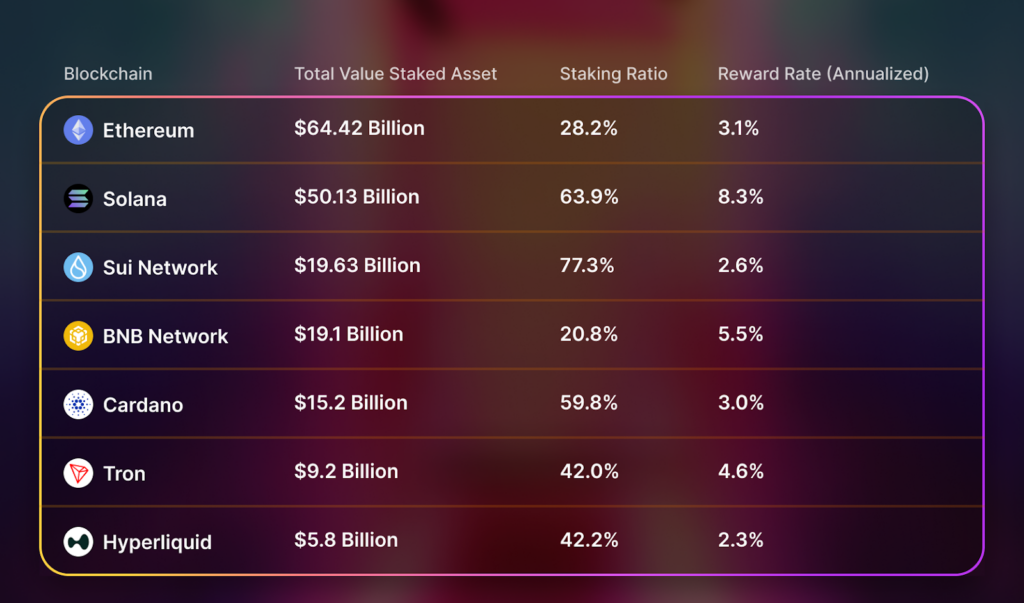Exploring the Highest Staking Rewards in the Crypto Market

Crypto staking has become a popular way for crypto holders to earn passive income from digital assets.
Famous Proof-of-Stake (PoS) and Delegated-Proof-of-Stake (DPoS) networks such as Ethereum (ETH) and Solana (SOL) have gathered over $120 billion worth of staked crypto combined.
However, with hundreds of blockchains in the market, how do you find the highest staking rewards?
In this article, we will guide you through:
- How to earn staking rewards
- The best crypto staking platforms
- How to choose the right staking projects
Hop in and learn about the highest staking rewards!
How To Earn Staking Rewards
PoS and DPoS act as consensus mechanisms for validating transactions and producing blocks. To become a validator, a participant who verifies transactions, you must stake or lock up your cryptocurrency on a blockchain to support the latter’s operations.
You receive staking rewards when you support the network and keep it secure. The amount and duration of your staked assets determine the staking rewards you will receive.
You earn rewards in the form of the network’s native tokens. Crypto staking ETH, for example, will also result in ETH rewards. However, as investors explore other staking methods such as liquid staking and restaking, rewards may be offered in a mix of the staked asset and/or the protocol’s native token.
With Lido Finance, an Ethereum liquid staking platform, a user earns stETH, a liquid staking token (LST) representing the user’s ETH holdings. A user can deploy stETH in decentralized finance protocols to gain more yield.
For example, a staker can utilize their staked ETH, stETH, in protocols such as EigenLayer to secure other blockchain projects and earn more rewards. This process of using already staked tokens is called restaking.
Factors to Consider When Choosing Crypto Staking Networks
While choosing the crypto with the highest staking Annual Percentage Yield (APY) seems logical, there is more to staking than meets the eye. For example, what is the use of a high staking APY if the network fails and the token crashes?
Consider various factors to make an informed decision when choosing a cryptocurrency for staking. Additionally, staying updated with market trends and community sentiment can provide valuable insights into potential staking opportunities.
Here are a few factors to consider:
Market Capitalization
The cryptocurrency market cap, short for market capitalization, refers to the total value of a cryptocurrency. It is calculated by multiplying the current price of a cryptocurrency by its total circulating supply.
Since starting to trade on crypto exchanges in October 2020, Polkadot has had a market cap of over $3.0 billion. The network has consistently ranked among the top 20 cryptocurrencies.
A high market capitalization usually implies market validation and trust, so you can be somewhat assured that your investment will not go to zero.
Team
Satoshi Nakamoto is the anonymous creator of Bitcoin. In the past, unknown developers and teams built the foundations of the crypto space. Nowadays, venture capital-backed teams create most new networks.
In this new paradigm, stakeholders must research and understand each network’s financial capacity and team credentials. Without proper backing, a staked network may never reach adoption or become a fly-by-night operator.
Network Governance
Governance mechanisms determine how decisions are made within the network, including protocol upgrades and changes. Transparent and decentralized governance can enhance trust in the cryptocurrency ecosystem.
In May 2024, a commenter on X (formerly Twitter) revealed how the Sui team holds 84% of the Sui Network’s total token supply. Critics argue that the team could quickly move the tokens and dump them into the open market. Such centralized governance can deter stakers from participating in staking activities on the network.
Where are the Highest Crypto Staking Rewards?
With hundreds of blockchain networks prowling the crypto space, where is the best place to earn staking rewards? Finding the highest staking rewards can be like finding a needle in a haystack.
We have curated a list of the biggest blockchain networks, ranked based on the total value of staked assets.
Data taken from stakingrewards.com as of March 28, 2025
Solana, the second-largest network in total staked assets, provides over 8% APY in staking rewards, far outpacing other large networks.
What Affects Crypto Staking Rewards?
Several factors can affect how you earn staking rewards.
While it is known that staking amount and duration can directly affect your rewards, other elements can cause staking rewards to fluctuate.
Staking Platforms
We have mentioned previously that various staking platforms take a commission from your rewards.
Lido Finance, the most popular Ethereum liquid staking platform, takes a 10% commission on earned rewards. Other staking pools may charge more depending on the network. Consider this when choosing networks and platforms to stake on.
Blockchain Network Parameters
Each blockchain network has rules and parameters that determine staking rewards. These rules can include the block reward size, the block time, the minimum stake amount, and the maximum supply of coins.
Cardano, a DPoS network, has a design called saturation. When a staking pool reaches a certain staked amount, it and its staker receive fewer rewards. This design prevents a staking pool from becoming too large and combats centralization.
Validator Performance
Validators performing well and maintaining high uptime are likelier to earn higher rewards. This is something to monitor when solo staking. Should your validator go offline for whatever reason – loss of electricity or home internet- you will lose rewards.
Validator and infrastructure uptime are one of the main reasons solo stakers may run their node through cloud hosting providers such as Amazon Web Services. These cloud services allow the staking process to run 24/7.
Understanding these factors will enable you to make informed decisions about crypto staking and maximize your rewards.
How Often Crypto Staking Rewards Are Distributed
A staker may receive staking rewards in various time frames depending on the networks. These can range from seconds to hours and days.
Crypto staking with Cosmos results in staking rewards approximately every 7 seconds. Meanwhile, investors crypto staking with SUI will earn rewards every 24 hours.
Compounding your staking rewards will also result in higher returns. Investors should also consider this rewards-time factor when choosing the network for their crypto assets.
How to Choose the Best Crypto Staking Platform
Choosing the best crypto staking platform depends on several factors.
You should consider:
- the cryptocurrency you want to stake
- the staking rewards offered
- the platform security
…and the user experience.
Depending on the person and their risk appetite, these factors help define the best crypto staking platform.
Here’s a breakdown of various staking platforms and things to consider:
Solo Staking
Solo Staking refers to crypto staking on a blockchain network by connecting directly to the network. A staker sets up their computer, which runs a copy of the blockchain software. These computers are called nodes.
By staking the required cryptocurrency, the node turns into a validator, which verifies transactions on the network.
Here are a few things to consider when choosing solo staking:
- Security: Solo staking is the most secure form of staking available. You do not rely on third parties and aren’t exposed to the security risks of those platforms and smart contracts.
- Capital Barriers: Solo staking can become expensive depending on the network. Setting up a validator can cost hundreds of thousands when you combine the cost of the computer infrastructure and the required staked crypto.
- Technical Requirements: To set up a node, you must learn coding and computer building. This can be daunting for many participants.
Staking Pool
With staking pools, users combine their funds with other participants. The staking platform operator manages the pool and maintains the hardware and software. Users receive staking rewards based on the amount and duration staked within the pool.
Many staking pools exist, from liquid staking and Delegated-Proof-of-Stake networks to crypto exchanges. While they are not as secure as solo staking, staking pools present many benefits:
- Accessibility: Staking pools (not including crypto exchanges) do not require any minimum staked amount nor an individual to perform Know-Your-Customer (KYC) processes. This provides accessibility from both a financial and identity standpoint.
- User Experience: Whether a beautiful platform or seamless user interface, third-party platforms aim to provide a great experience. For crypto exchanges such as Kraken, their all-in-one offering, from staking to trading, allows users to access everything from the Kraken platform.
- Commissions: Unlike solo staking, where a staker gets all the staking rewards, the third-party platform will take a commission ranging from 10% to 30%.
Risks Involved in Staking Coins for Passive Income
As good as it may sound, staking is not a risk-free investment. Even staking for large networks or protocols can lead to an absolute investment loss. Make sure to consider the risks before engaging in staking.
Capital Loss
Many blockchains launched during 2020-2021 have yet to recover in token prices.
Flow Blockchain once supported a price of $20 per token but has since collapsed to less than $1. While the staking rewards are decent at 7%-11% APY, this does not compensate for the drop in token prices. Investors who have been staking since 2021 have yet to recover their investments.
Opportunity Costs
Aside from staking, investors can choose several methods to generate investment yields. This may include airdrop farming, yield farming, and engaging with other protocols, which may have higher returns.
As there is a time component, you can lose out on opportunities in between unlocking your staked assets.
Some platforms allow you to qualify for token airdrops while staking on their application to combat the opportunity costs of staking. Polli.co, a staking optimization platform, enables you to remain in custody of your crypto and any associated airdrop rewards.
General Security
Attack vectors increase as you interact with various applications and links throughout your staking journey. If you are not careful, malicious actors can attack you and lead to the loss of crypto assets.
Crypto Staking as a Way to Achieve Financial Growth
Staking crypto has become a viable method for generating passive income. As of writing, investors have staked hundreds of billions worth of crypto tokens. Rather than keep idle crypto assets, you can help secure a blockchain and receive crypto rewards in return.
With hundreds of blockchains, however, it is essential to conduct due diligence and select the network and platform that will result in the best staking rewards for you. Consider factors such as commissions, security, and capital barriers to entry.
The content of solostakers.com is for informational purposes only and should not be considered financial advice. It represents the personal views and opinions of the author(s) and is not endorsed by any financial institution or regulatory body. Cryptocurrency and staking investments carry inherent risks and readers should conduct their own research and consult with a financial professional before making any investment decisions. The owner and author(s) of solostakers.com will not be liable for any losses, damages, or consequences arising from the use of the information on this site. By accessing solostakers.com, you agree to bear full responsibility for your investment decisions.
April 3, 2024
July 14, 2025







